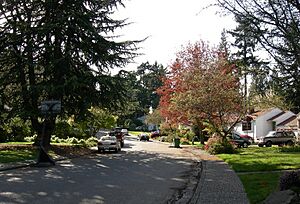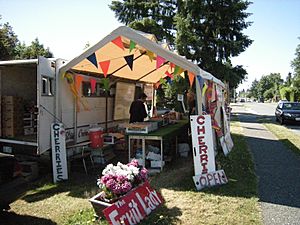Wedgwood, Seattle facts for kids
Quick facts for kids
Wedgwood
|
|
|---|---|
|
Seattle Neighborhood
|
|
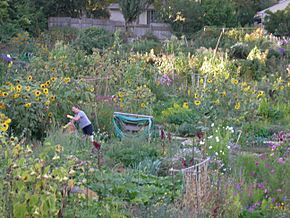
The Picardo Farm P-Patch community garden in Wedgwood
|
|
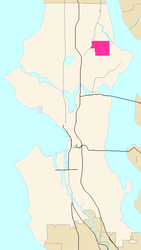
Map of Wedgwood's location in Seattle
|
|
| Country | |
Wedgwood is a neighborhood in northeast Seattle, Washington. It's mostly a place where people live, with some shops and businesses. Wedgwood is about 2 miles (3.2 km) north of the University of Washington. It is also about 6 miles (9.7 km) northeast of Downtown Seattle.
Sometimes, people misspell the name as "Wedgewood." But the correct spelling is "Wedgwood." The neighborhood was named after a famous English company that makes bone china. Albert Balch (1903–1976) was the developer who named the area. His wife loved the china, so he chose the name. Balch also started the nearby neighborhood of View Ridge.
Contents
Exploring Wedgwood's Past
Early Days and the Big Rock
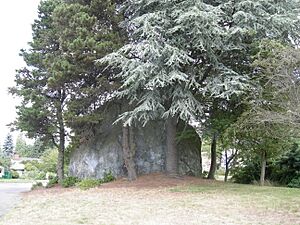
People have lived in this area for a very long time. It was settled after the last Ice Age, about 10,000 years ago. Native American tribes, like the Dkhw'Duw'Absh and the xachua'bsh (now part of the Duwamish tribe), used to hunt and travel through what is now Wedgwood.
A huge rock, called the Wedgwood Rock, became a meeting point for trails. This rock is 19 feet (5.8 m) tall and 75 feet (23 m) around. It's a glacial erratic, meaning it was left behind by a glacier. The neighborhood saved this "Big Rock" from being built over in 1941.
From Farm to Neighborhood
The main part of Wedgwood used to be a thick forest. Charles E. Thorpe owned 40 acres (16 hectares) of land here. He built a log cabin from his own trees. By the 1920s, 35th Avenue NE was becoming a busy road. Electricity, water, and sewer lines were added.
In 1929, the Jesuits (a religious group) bought Thorpe's land. They planned to build a new campus for Seattle University there. But then the Great Depression hit, and their plans were put on hold. Thorpe's cabin became St. Ignatius Parish, a church.
By 1940, the Jesuits decided not to move Seattle University. They sold the land to Albert Balch for much less than they paid. A Catholic church, Our Lady of the Lake, is still in the neighborhood today.
Building Wedgwood Homes
When Albert Balch bought the land, it was mostly undeveloped. It had many trees and only Thorpe's cabin.
During World War II, Wedgwood started to grow quickly. Balch and his partner, Maury Seitzer, built homes for defense workers. They built 500 homes on 40 acres. At that time, Wedgwood was outside Seattle's city limits.
In 1943, Wedgwood residents started their own Volunteer Fire Department. It joined the city's fire department in 1945. Many of the volunteer firefighters during the war were women.
Balch designed the houses in the Cape Cod style. Each house was a little different. They were built to last and many are still standing today.
Other parts of Wedgwood also have interesting histories. One area, between 40th and 45th Avenues NE, was a Boy Scout camp until the 1950s. It was a quiet, wooded area with no traffic noise or electric lights.
Picardo Farm and Dahl Playfield
The large P-Patch Community Garden in Wedgwood used to be a working farm. It was called Picardo Farm, named after the family who farmed it from 1922 to 1965. Wedgwood has Seattle's oldest and largest P-Patch garden. These gardens allow people to grow their own food.
Just south of the old Picardo Farm is Dahl Playfield. This area was once a peat bog (a type of wetland). In the 1940s, some houses were built there. But they started sinking because of the soft ground. The city bought the houses and turned the land into a park.
In 1952, the bog caught fire! The ground sank up to 5 feet (1.6 m). Over the next few years, a lot of new dirt was brought in to fill the area. The park reopened and was named after Waldo J. Dahl, a former park director.
Local Businesses and Community Life
Shopping and Services
The first store in Wedgwood opened in 1922. It was run by Mr. and Mrs. Nick Jacklin. The building is now a garage for a house.
Later, McGillivray's Variety and Gift Store was in the same block. It sold everything from penny candy to special dolls. McVicar's Hardware Store opened after World War II. They sold tools, garden supplies, and even rented skis. They were known for helping people with "do-it-yourself" projects.
Today, there are many shops along 35th Avenue NE, especially around NE 75th Street and NE 85th Street. The Wedgwood Broiler is a popular restaurant there. The neighborhood also has a post office.
Just south of Wedgwood's unofficial boundary is the Seattle Public Library Northeast Branch. It's the largest neighborhood library and one of the busiest in Seattle.
Community Groups and Music
Wedgwood residents are active in their community. In 1946, they formed the Wedgwood Community Club. Today, the Wedgwood Community Council helps organize the neighborhood.
The Seattle Festival Orchestra (SFO) is a non-profit orchestra that practices and performs in Wedgwood. It was started in 1971 and includes musicians of all ages. They perform at the University Prep Academy.
Schools in Wedgwood
Wedgwood has several schools for different age groups:
- Wedgwood Elementary School (Kindergarten–5th grade)
- Our Lady of the Lake Parish School (preschool–8th grade)
- Concordia Lutheran School (preschool–8th grade)
- Nathan Eckstein Middle School (6th–8th grade)
- University Prep (6th–12th grade)
- Students from Wedgwood attend either Nathan Hale High School or Roosevelt High School.
Places of Worship
Wedgwood is home to many different religious groups. It is one of the centers for Seattle's Jewish community.
- Stroum Jewish Community Center
- Temple Beth Am (Reform synagogue)
- Congregation Beth Shalom (Conservative synagogue)
Christian churches in Wedgwood include:
- Messiah Lutheran Church
- Wedgwood Presbyterian Church
- Our Lady of the Lake Catholic Church
- Wedgwood Community Church
- University Unitarian Church
OneLife Community Church also meets in Wedgwood.
Wedgwood's Borders
Like many neighborhoods in Seattle, Wedgwood doesn't have official borders that everyone agrees on.
The unofficial City Clerk's Neighborhood Map Atlas says Wedgwood is:
- North: NE 95th Street
- East: 45th Avenue NE
- South: NE 75th Street
- West: 25th Avenue NE, then NE 85th Street, then Lake City Way NE to NE 95th Street.
However, many businesses and churches south of NE 75th Street also say they are in Wedgwood. For example, the famous Wedgwood Rock would be outside Wedgwood if these unofficial borders were strictly followed.
Other maps and local groups have slightly different ideas about where Wedgwood begins and ends. But generally, it's known as a friendly, middle-class neighborhood that's becoming popular with young families.
Images for kids


